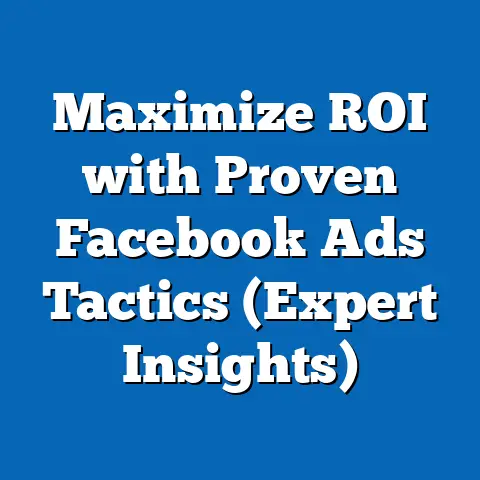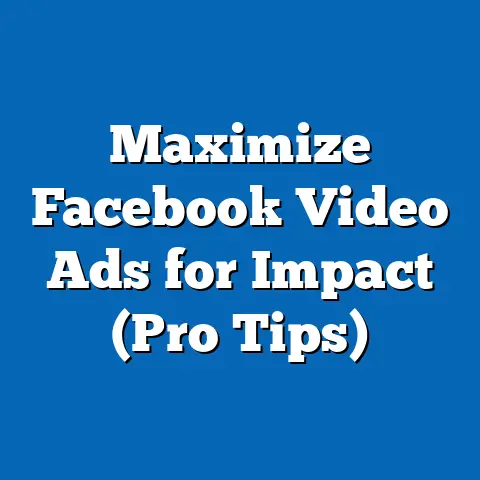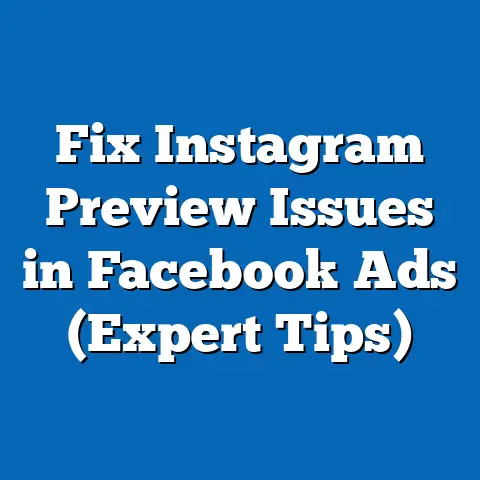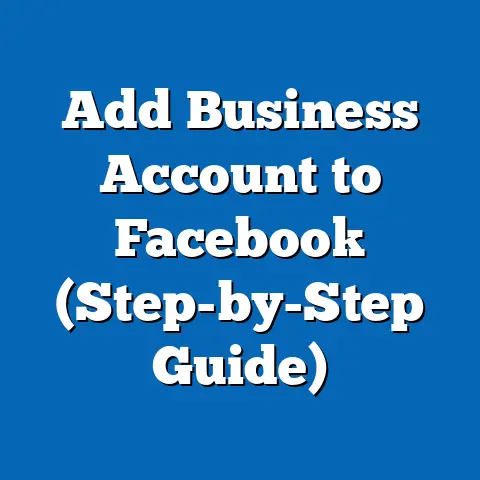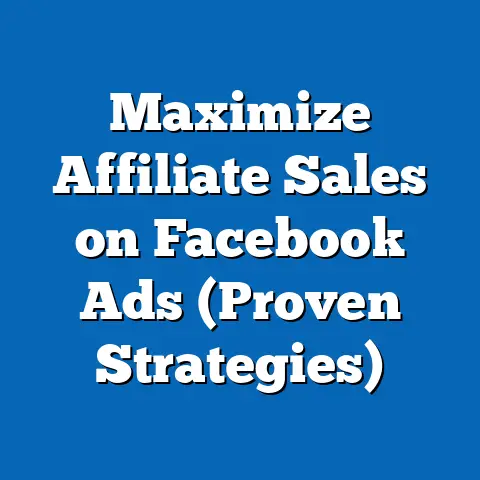How Facebook Targets Ads (Unveiling the Secret Algorithms)
We’ve all been there. You idly browse a website, casually mention a product to a friend, or even just think about something, and suddenly, there it is: an ad for that exact thing popping up on your Facebook feed. It can feel a little…creepy, right? But behind this seemingly psychic ability lies a complex system of data collection, analysis, and algorithms. In this article, I’m going to pull back the curtain and explore how Facebook targets ads, delving into the “secret algorithms” that power one of the most sophisticated advertising platforms in the world.
For years, businesses relied on traditional advertising methods like billboards, TV commercials, and print ads. I remember helping my dad with his local hardware store’s newspaper ads. We’d meticulously craft the layout, choose the fonts, and hope it caught the eye of someone needing a new hammer or some garden supplies. But it was largely guesswork. We’d target the local paper, assuming most people in our town read it, but we had no real way of knowing who actually saw the ad, let alone who was influenced by it. These methods were expensive, difficult to track, and relied on broad demographic targeting. There was no way to know if our investment was actually paying off.
The digital age has completely transformed advertising. Data, analytics, and precise targeting are now the name of the game. And Facebook, with its massive user base and sophisticated algorithms, has become a dominant player in this new landscape. So, let’s dive into the inner workings of Facebook’s ad targeting machine.
1. The Evolution of Advertising
1.1 Traditional Advertising Practices
Traditional advertising was built on assumptions and broad strokes. Market research, focus groups, and demographic data were used to create a general profile of the target audience. Ads were then placed in mass media channels like TV, radio, newspapers, and magazines, hoping to reach a significant portion of that audience.
Think about those classic Super Bowl commercials. They cost millions of dollars for a 30-second spot, and while they reached a huge audience, the targeting was incredibly broad. Sure, they might target males aged 18-49 for beer commercials, but that’s a huge demographic. Many viewers wouldn’t be interested in beer at all.
According to a Nielsen study, only about 36% of consumers trust traditional advertising. This highlights one of the biggest problems with these methods: a lack of personalization and relevance. The message is the same for everyone, regardless of their individual needs and interests.
Takeaway: Traditional advertising relies on mass media and broad demographic targeting, leading to low engagement and difficulty in measuring ROI.
1.2 The Rise of Digital Advertising
The internet changed everything. Suddenly, advertisers had access to vast amounts of data about individual users, allowing for much more precise targeting. Digital advertising platforms like Google Ads and Facebook Ads emerged, offering businesses the ability to reach specific audiences based on their interests, behaviors, and demographics.
The shift to digital advertising has been dramatic. According to Statista, digital ad spending worldwide is projected to reach over $600 billion by 2024. This reflects the growing recognition of the power of data-driven advertising.
Facebook, in particular, has revolutionized advertising by leveraging its massive user base and sophisticated algorithms to create highly targeted ad campaigns. It’s not just about demographics anymore. Facebook tracks everything from the pages you like to the articles you read, the products you buy, and even the words you use in your posts. This data is then used to create incredibly detailed user profiles, allowing advertisers to reach exactly the right people with the right message.
Takeaway: Digital advertising leverages data and analytics to target specific audiences, leading to higher engagement and better ROI compared to traditional methods. Facebook is a leading platform in this revolution.
2. Understanding Facebook Ads
2.1 Overview of Facebook Advertising
Facebook’s advertising services have evolved significantly since their inception. Initially, ads were simple banner ads that appeared on the side of the page. But as the platform grew and its data collection capabilities improved, so did its advertising options.
Today, Facebook offers a wide range of ad formats, including:
- Image Ads: Simple and effective for showcasing products or services with a compelling visual.
- Video Ads: Great for storytelling and capturing attention.
- Carousel Ads: Allow users to scroll through multiple images or videos in a single ad.
- Collection Ads: Designed for e-commerce, showcasing a catalog of products.
- Lead Ads: Collect leads directly within the Facebook platform.
- Instant Experience Ads: Full-screen, mobile-optimized ads that load instantly.
- Story Ads: Appear in the stories section, offering a more immersive experience.
Each ad format has its own strengths and is suited for different purposes. For example, a clothing retailer might use carousel ads to showcase their latest collection, while a service provider might use lead ads to collect contact information from potential customers.
Takeaway: Facebook offers a diverse range of ad formats to suit different business needs and marketing objectives.
2.2 The Facebook Ads Ecosystem
The Facebook Ads ecosystem is a complex network of tools and processes that work together to deliver targeted ads to users. Key components include:
- Ads Manager: The central hub for creating, managing, and tracking Facebook ad campaigns.
- Audience Insights: Provides data and insights about your target audience, helping you refine your targeting strategy.
- Pixel: A piece of code that you place on your website to track user behavior and conversions.
- Business Manager: A tool for managing multiple Facebook pages, ad accounts, and users.
- Analytics: Provides detailed data about the performance of your ads, including impressions, clicks, conversions, and ROI.
The advertising process involves several key players:
- Advertisers: Businesses or individuals who create and run ad campaigns.
- Users: Facebook users who see and interact with the ads.
- Facebook: The platform that facilitates the advertising process, collecting user data, delivering ads, and providing analytics.
The entire ecosystem is designed to be a win-win for all parties involved. Advertisers get to reach their target audience with relevant ads, users get to see ads that are tailored to their interests, and Facebook generates revenue from the advertising platform.
Takeaway: The Facebook Ads ecosystem is a complex network of tools, processes, and players that work together to deliver targeted ads to users.
3. How Facebook Targets Ads
3.1 User Data Collection
Facebook’s ability to target ads so effectively is based on its vast collection of user data. The platform tracks everything from the pages you like to the articles you read, the products you buy, and even the words you use in your posts.
Here are some of the key ways Facebook collects user data:
- Direct Data: Information you provide directly to Facebook, such as your name, age, gender, location, education, and interests.
- Behavioral Data: Data about your activity on Facebook, such as the pages you like, the posts you share, the comments you make, and the events you attend.
- Interest Data: Inferred interests based on your activity on Facebook, such as your hobbies, favorite brands, and preferred topics.
- Demographic Data: Information about your demographics, such as your age, gender, location, income, and education.
- Website Data: Data collected through the Facebook Pixel, which tracks your activity on websites that have implemented the Pixel.
- App Data: Data collected through the Facebook SDK, which tracks your activity within mobile apps that have integrated the SDK.
- Offline Data: Data uploaded by advertisers, such as customer lists and purchase histories.
Cookies and pixels play a crucial role in tracking user interactions both on and off the platform. A cookie is a small text file that websites store on your computer to remember your preferences. The Facebook Pixel is a piece of code that websites place on their pages to track user behavior and conversions.
For example, if you visit a website that sells shoes and browse a particular pair, the Facebook Pixel will track that activity. Later, when you’re browsing Facebook, you might see an ad for that exact pair of shoes.
Takeaway: Facebook collects a vast amount of user data through various channels, including direct data, behavioral data, website data, and app data. Cookies and pixels play a crucial role in tracking user interactions.
3.2 The Secret Algorithms Behind Targeting
The real magic of Facebook’s ad targeting lies in its sophisticated algorithms. These algorithms use machine learning and artificial intelligence to analyze user data and create detailed user profiles.
Here’s how it works:
- Data Collection: Facebook collects data from various sources, as described above.
- Data Processing: The data is processed and analyzed using machine learning algorithms.
- User Profiling: The algorithms create detailed user profiles, including interests, habits, demographics, and purchase intent.
- Ad Matching: When an advertiser creates an ad campaign, they specify their target audience based on various criteria. The algorithms then match the ad to the users who are most likely to be interested in it.
- Ad Delivery: The ad is delivered to the targeted users through their Facebook feed, stories, or other placements.
- Performance Tracking: Facebook tracks the performance of the ad, including impressions, clicks, conversions, and ROI.
- Algorithm Refinement: The data collected from the ad performance is used to refine the algorithms and improve ad targeting.
The algorithms are constantly learning and adapting to changing user behavior. This means that the targeting becomes more precise over time, leading to higher engagement and better ROI for advertisers.
For example, if you consistently click on ads for hiking gear, the algorithms will identify you as someone interested in hiking. You’ll then be more likely to see ads for hiking trails, camping equipment, and other related products.
Takeaway: Facebook’s algorithms use machine learning and AI to analyze user data, create detailed user profiles, and match ads to the most relevant users. The algorithms are constantly learning and adapting to improve ad targeting.
3.3 Audience Segmentation and Custom Audiences
Facebook allows advertisers to segment their audiences in various ways, including:
- Demographic Targeting: Target users based on their age, gender, location, education, and other demographic factors.
- Interest Targeting: Target users based on their interests, hobbies, and favorite brands.
- Behavioral Targeting: Target users based on their online behavior, such as their purchase history, travel habits, and device usage.
- Lookalike Audiences: Create audiences that are similar to your existing customers.
- Custom Audiences: Upload your own customer lists to target specific individuals.
Lookalike audiences are a powerful tool for expanding your reach and finding new customers. You can upload a list of your best customers, and Facebook will create an audience of users who share similar characteristics and behaviors.
Custom audiences allow you to target specific individuals based on their email addresses, phone numbers, or other identifying information. This is particularly useful for retargeting existing customers or reaching out to potential customers who have already expressed interest in your products or services. I once used this to re-engage a list of abandoned cart users for an e-commerce client, and the results were phenomenal, significantly boosting conversion rates.
Takeaway: Facebook offers a variety of audience segmentation options, including demographic targeting, interest targeting, behavioral targeting, lookalike audiences, and custom audiences. These tools allow advertisers to reach specific niches effectively.
4. The Role of Engagement Metrics
4.1 Measuring Ad Performance
Facebook uses various key performance indicators (KPIs) to measure ad effectiveness. Some of the most important KPIs include:
- Impressions: The number of times your ad is shown to users.
- Reach: The number of unique users who see your ad.
- Clicks: The number of times users click on your ad.
- Click-Through Rate (CTR): The percentage of users who see your ad and click on it.
- Conversions: The number of users who take a desired action after seeing your ad, such as making a purchase, filling out a form, or downloading an app.
- Conversion Rate: The percentage of users who click on your ad and then take a desired action.
- Cost Per Click (CPC): The average cost you pay for each click on your ad.
- Cost Per Conversion (CPA): The average cost you pay for each conversion.
- Return on Ad Spend (ROAS): The amount of revenue you generate for every dollar you spend on advertising.
By tracking these metrics, advertisers can gain valuable insights into the performance of their ad campaigns and refine their strategies accordingly. For example, if your CTR is low, it might indicate that your ad copy or creative is not engaging enough. If your CPA is high, it might indicate that your targeting is too broad or that your landing page is not optimized for conversions.
Takeaway: Facebook uses various KPIs to measure ad effectiveness, including impressions, reach, clicks, CTR, conversions, conversion rate, CPC, CPA, and ROAS. Advertisers can use these metrics to refine their strategies and improve their ROI.
4.2 The Feedback Loop
Facebook uses engagement data to continually refine its algorithms and improve ad targeting. This creates a feedback loop that benefits both advertisers and users.
Here’s how the feedback loop works:
- Ad Delivery: Facebook delivers ads to targeted users.
- User Engagement: Users interact with the ads by clicking, liking, sharing, or commenting.
- Data Collection: Facebook collects data about user engagement.
- Algorithm Refinement: The data is used to refine the algorithms and improve ad targeting.
- Improved Targeting: The improved targeting leads to higher engagement and better ROI for advertisers.
- More Relevant Ads: The more relevant ads lead to a better user experience.
The feedback loop is constantly running, ensuring that the algorithms are always learning and adapting to changing user behavior. This means that the targeting becomes more precise over time, leading to better results for advertisers and a more relevant experience for users.
However, this feedback loop also has implications for user privacy. The more data Facebook collects about user engagement, the more detailed the user profiles become, raising concerns about data security and the potential for misuse.
Takeaway: Facebook uses engagement data to continually refine its algorithms and improve ad targeting, creating a feedback loop that benefits both advertisers and users. However, this feedback loop also raises concerns about user privacy.
5. The Ethical Implications of Targeted Advertising
5.1 Privacy Concerns
Targeted advertising raises significant privacy concerns. The vast amount of data that Facebook collects about its users, combined with the sophisticated algorithms used to analyze that data, creates the potential for misuse and manipulation.
Users are often unaware of the extent to which their data is being collected and used. They may not realize that their likes, shares, and comments are being tracked and analyzed to create detailed user profiles. They may also not realize that their online activity is being tracked through cookies and pixels, even when they’re not on Facebook.
Regulations like GDPR (General Data Protection Regulation) and CCPA (California Consumer Privacy Act) have been enacted to protect user privacy and give users more control over their data. These regulations require companies to be transparent about their data collection practices and to obtain consent from users before collecting and using their data.
Facebook has implemented various measures to comply with these regulations, such as allowing users to access and delete their data, and providing more transparency about how their data is being used. However, privacy concerns remain, and many users are still wary of targeted advertising.
Takeaway: Targeted advertising raises significant privacy concerns due to the vast amount of data collected and the potential for misuse. Regulations like GDPR and CCPA have been enacted to protect user privacy.
5.2 The Balance Between Relevance and Intrusiveness
There’s a fine line between personalized advertising and invasive practices. Users appreciate seeing ads that are relevant to their interests, but they also don’t want to feel like they’re being stalked or manipulated.
The key is to strike a balance between relevance and intrusiveness. Advertisers should focus on providing value to users by offering products or services that genuinely meet their needs. They should also be transparent about their data collection practices and give users control over their data.
User sentiment towards targeted ads is mixed. Some users appreciate the convenience of seeing ads that are tailored to their interests, while others find them annoying or creepy. A study by Pew Research Center found that 79% of Americans are concerned about how companies use their personal data.
Businesses can navigate this balancing act by:
- Being Transparent: Clearly communicate your data collection practices to users.
- Providing Value: Offer products or services that genuinely meet users’ needs.
- Giving Users Control: Allow users to access and delete their data.
- Respecting Privacy: Avoid collecting or using data that is not necessary for providing a valuable service.
- Being Mindful of Context: Consider the context in which your ads are being shown and avoid being intrusive or disruptive.
Takeaway: There’s a fine line between personalized advertising and invasive practices. Businesses can navigate this balancing act by being transparent, providing value, giving users control, respecting privacy, and being mindful of context.
Conclusion: The Future of Advertising on Facebook
Facebook’s targeting algorithms have revolutionized advertising, allowing businesses to reach specific audiences with unprecedented precision. By collecting vast amounts of user data and using sophisticated machine learning algorithms, Facebook has created a powerful advertising platform that delivers highly relevant ads to users.
However, this power comes with ethical responsibilities. Privacy concerns remain a significant challenge, and businesses must strike a balance between relevance and intrusiveness.
The future of advertising on Facebook is likely to be shaped by several factors, including:
- Technological Advancements: New technologies like augmented reality and virtual reality could create new opportunities for advertising.
- Changing User Behavior: As users become more aware of data collection practices, they may become more resistant to targeted advertising.
- Privacy Regulations: Stricter privacy regulations could limit the amount of data that Facebook can collect and use.
- Competition: New advertising platforms may emerge, challenging Facebook’s dominance in the market.
Ultimately, the success of advertising on Facebook will depend on its ability to adapt to these changes and continue to provide value to both advertisers and users. The ongoing evolution of advertising will continue to shape how businesses and consumers interact, and it’s crucial to stay informed and adapt to these changes. Only then can we ensure that advertising remains a valuable tool for businesses while respecting the privacy and preferences of consumers.

